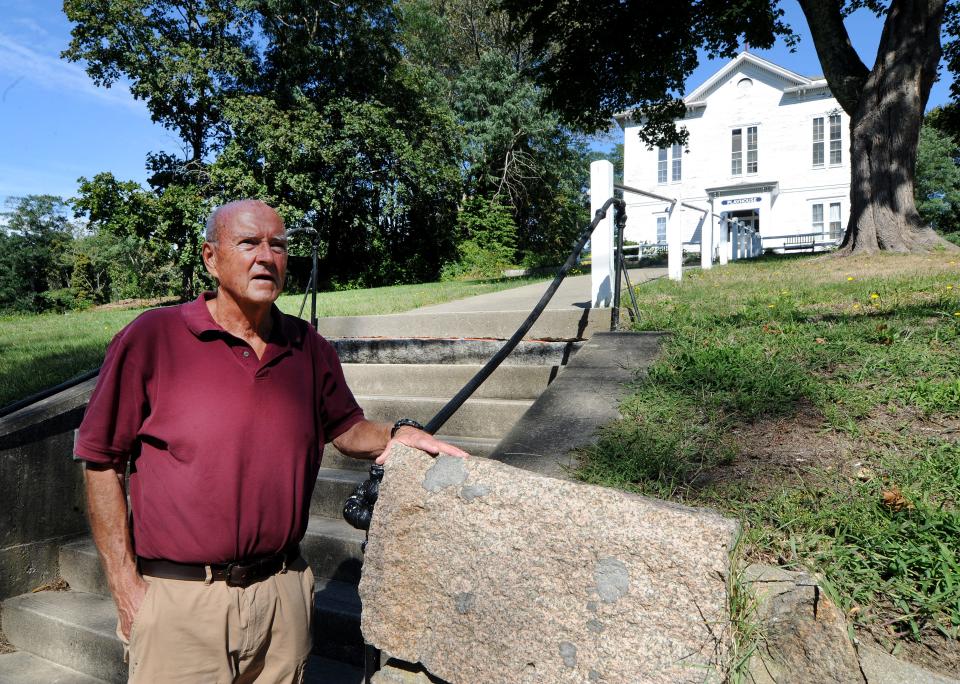What's it like to live in a local historic district? Orleans ponders its first
Imagine taking a stroll through Orleans in the 1800s, past the Captain Simeon Mayo House and the 1873 Town Hall.
You would have seen the Universalist Society Meetinghouse (1834), the South Parish Church (1829), and the William Myrick General Store (1830 or so) along Main Street.
Well, you can do that today and still get a sense of what Orleans was like 150 years ago.
The Orleans Historical Commission would like to make sure that’s still possible years from now.

“This has been a four-year journey looking to establish a historical district on Main Street,” Ron Petersen of the Historical Commission told the Select Board on Sept. 21. “This town has a rich history and heritage and the visual evidence of that heritage is disappearing every year. We don’t want to impede progress or (have) a historic district with overbearing restrictions. We’re just looking to manage progress.”
At the Sept. 21 meeting, the Select Board did not take a vote on moving forward with the proposal.
More: Here's the story behind the chair on Brewster's town seal. Is it time for a change?
There are 22 historic districts on Cape Cod and the Islands and over 100 towns in Massachusetts have them, according to the Massachusetts Historical Commission website.
Taking inventory of historic sites
The commission in Orleans has documented 41 19th century buildings still standing along Main Street between the intersection of Route 28 and the junction with Barley Neck Road, a 1.2-mile stretch. That doesn’t include two cemeteries dating to 1723 and 1836 and two Civil War memorials and Veteran’s Park.
The proposed district is a mostly residential stretch that passes by the current Town Hall and annex, as well as most of the commercial section of East Orleans.
The commission has researched each property, determining who built it, what they did, where the sea captains sailed and who they married.
More: Orleans Underground Mall redevelopment to include affordable housing
More: Holding onto the past: Sandwich officials fret loss of historic homes to demolition, neglect
More: Here's the story behind the chair on Brewster's town seal. Is it time for a change?
For instance, Calvin Snow built his home at 94 Main St. in 1840. He was a selectman and tinsmith who moved to Chicago at age 42 to enter the meat packing industry. He retired back to Orleans and sold the home in 1860 to Davis Hurd who converted it to a general store. The old 1873 Town Hall lasted until 1956 and then became the Academy Playhouse.
“Some are well preserved,” Petersen said of the 19th century homes. “But they’ve changed because people’s ways of living have changed.”
Rather than an architectural conservation district the commission would prefer to see a "local historic district" as provided for under state law Chapter 40C.
“The big thing we’re asking is for the Select Board to appoint a study committee to look at a Chapter 40 C type local historic district,” Joan Nix, a member of the Historic Commission, said. “We believe that is the best type of historic district. An architectural conservation district isn’t very flexible and the state is not comfortable with them anymore.”
Deciding on a type of historic district
The architectural conservation districts can draw more complaints and lawsuits from property owners, Nix noted.
“This meets the same goals with as little regulation as possible, but prevents the demolition of historic structures and reviews major alterations," she said. "But it won’t regulate wind turbines, solar panels, what color you paint your house, what type of siding."
Nix said the commission has done a lot of work already cataloging the homes and their history. That would be made available to the proposed study committee of five to seven members.
More: Here's a new way the public might be able to get across Quivett Marsh to Cape Cod Bay
“Previous (proposed) districts failed because they were overreaching,” Nix said. “Everything was brought before the Historic Commission.”
The next step besides the study committee would be to survey the residents on Main Street in the proposed district, determine the boundaries, and then produce a study report and proposed bylaw. The bylaw would need to be reviewed by the Orleans Planning Board and the Massachusetts Historical Commission.
Eventually, if the measure progresses, a warrant article containing the local historic district bylaw would go before Town Meeting for approval.
“I’m fully in support,” Select Board member Kevin Galligan said.
The Select Board indicated on Sept. 21 that it intended to wait to vote on a charge and formula for the proposed study committee.
Contact Rich Eldred at reldred@capecodonline.com. Follow him on Twitter: @reldredCodder.
This article originally appeared on Cape Cod Times: Orleans ponders local historic district in area with 1800s properties

